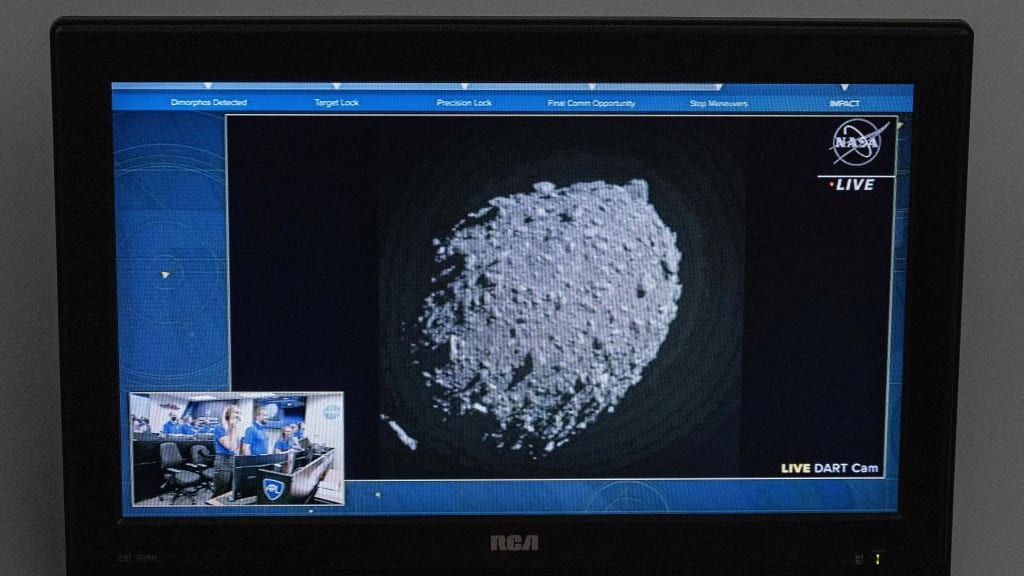NASA's DART mission is a success as it crashes into asteroid


A NASA spacecraft successfully slammed into an asteroid on Monday evening, testing technology that could be used in the future to protect Earth.
The Double Asteroid Redirection Test (DART) spacecraft hit the asteroid at 14,000 miles per hour, in a test to see if DART could knock it off its path. NASA is looking for ways to defend the planet from asteroids and smaller objects hurtling through space, which are "far more numerous, and although they would not set off mass extinctions, they can unleash more energy than a nuclear bomb," The New York Times writes.
The 560-foot-wide asteroid DART hit, named Dimorphos, was not approaching the Earth, making it a good target for possible deflection. Over the next several weeks, NASA scientists and the other engineers working on DART will go through the data and images collected to learn what happened to Dimorphos after DART crashed into it.
The Week
Escape your echo chamber. Get the facts behind the news, plus analysis from multiple perspectives.

Sign up for The Week's Free Newsletters
From our morning news briefing to a weekly Good News Newsletter, get the best of The Week delivered directly to your inbox.
From our morning news briefing to a weekly Good News Newsletter, get the best of The Week delivered directly to your inbox.
A free daily email with the biggest news stories of the day – and the best features from TheWeek.com
Catherine Garcia has worked as a senior writer at The Week since 2014. Her writing and reporting have appeared in Entertainment Weekly, The New York Times, Wirecutter, NBC News and "The Book of Jezebel," among others. She's a graduate of the University of Redlands and the Columbia University Graduate School of Journalism.
-
 Antibiotic resistance: the hidden danger on Ukraine’s frontlines
Antibiotic resistance: the hidden danger on Ukraine’s frontlinesUnder The Radar Threat is spreading beyond war zones to the ‘doorstep’ of western Europe
-
 ‘Capitalism: A Global History’ by Sven Beckert and ‘American Canto’ by Olivia Nuzzi
‘Capitalism: A Global History’ by Sven Beckert and ‘American Canto’ by Olivia NuzziFeature A consummate history of capitalism and a memoir from the journalist who fell in love with RFK Jr.
-
 Who will the new limits on student loans affect?
Who will the new limits on student loans affect?The Explainer The Trump administration is imposing new limits for federal student loans starting on July 1, 2026
-
 Blue Origin launches Mars probes in NASA debut
Blue Origin launches Mars probes in NASA debutSpeed Read The New Glenn rocket is carrying small twin spacecraft toward Mars as part of NASA’s Escapade mission
-
 ‘The Big Crunch’: why science is divided over the future of the universe
‘The Big Crunch’: why science is divided over the future of the universeThe Explainer New study upends the prevailing theory about dark matter and says it is weakening
-
 Dinosaurs were thriving before asteroid, study finds
Dinosaurs were thriving before asteroid, study findsSpeed Read The dinosaurs would not have gone extinct if not for the asteroid
-
 The moon is rusting
The moon is rustingUnder the radar The Earth is likely to blame
-
 Panspermia: the theory that life was sent to Earth by aliens
Panspermia: the theory that life was sent to Earth by aliensUnder The Radar New findings have resurfaced an old, controversial idea
-
 Africa could become the next frontier for space programs
Africa could become the next frontier for space programsThe Explainer China and the US are both working on space applications for Africa
-
 SpaceX breaks Starship losing streak in 10th test
SpaceX breaks Starship losing streak in 10th testspeed read The Starship rocket's test flight was largely successful, deploying eight dummy satellites during its hour in space
-
 Hurricanes are not exclusive to Earth. They can happen in space.
Hurricanes are not exclusive to Earth. They can happen in space.Under the radar These storms may cause navigational problems
